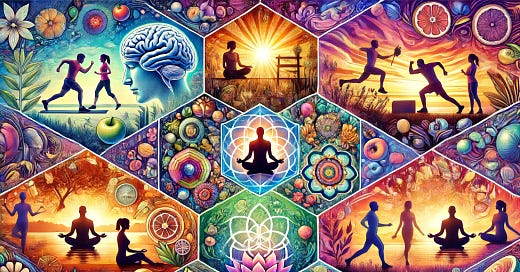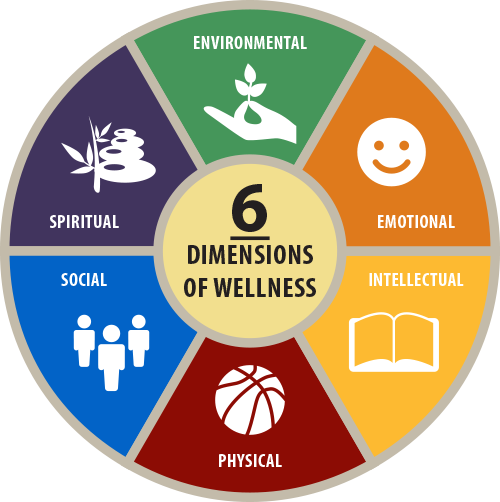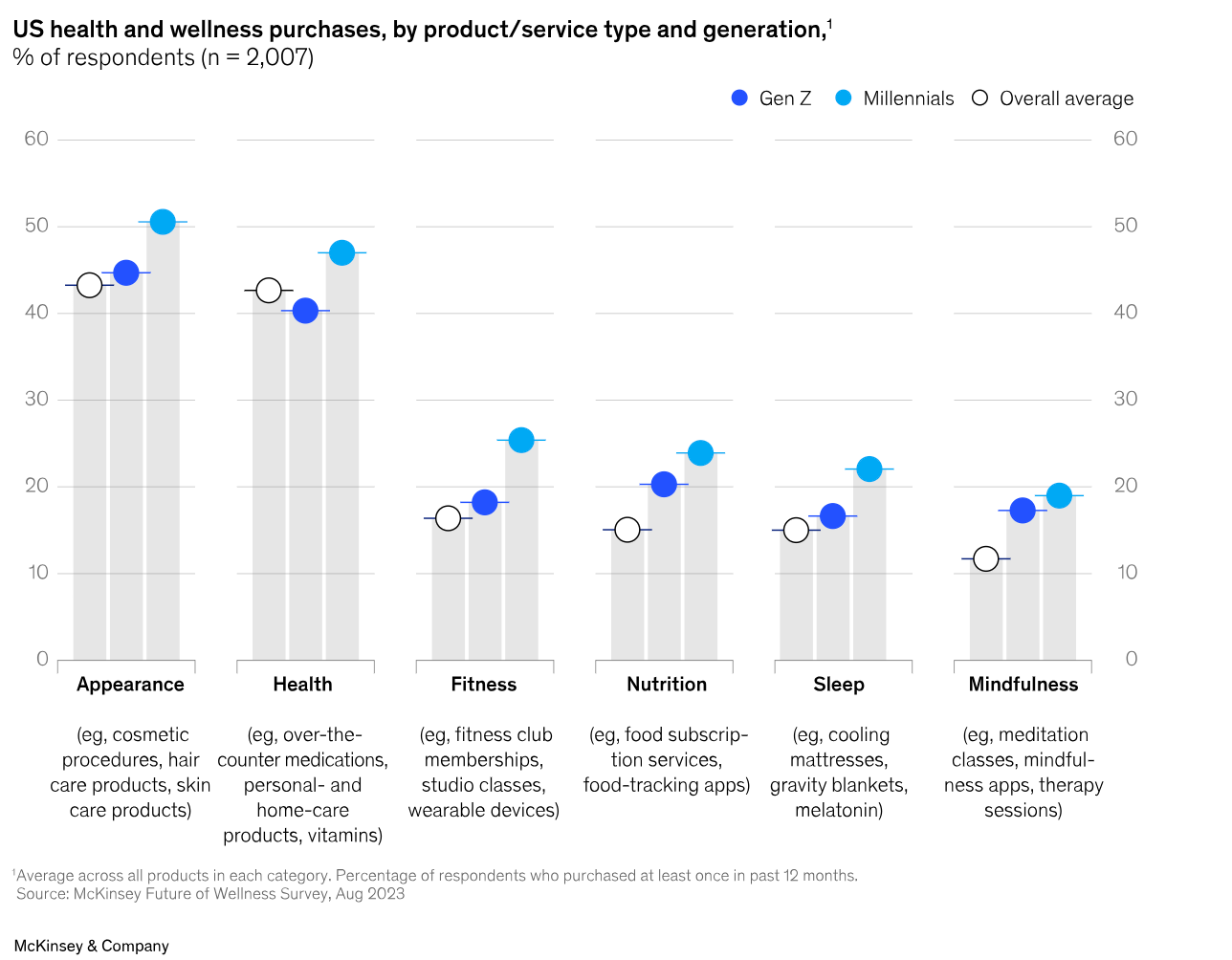In 2024, it feels like every day brings a new breakthrough in the wellness industry. McKinsey recently released a report estimating that the wellness market has reached $480B at a 5-10% CAGR in 2024. 82% of US consumers now consider wellness a top priority. Whether it’s the introduction of wearables and biometric tracking, the emergence of GLP-1 drugs like Ozempic, or the obsession over backyard cold-plunges, individuals are doubling down on taking care of themselves. That’s a good thing… right?
This inundation of information, tools, and trends can be overwhelming. For those new to their health journey, where do they start? Who do they listen to? Who do they trust? Even defining what wellness means becomes a challenge.
I’m fascinated by why society is investing so much in overall well-being and which technologies and companies are taking advantage of the shifting tides. In this initial dive, I hope to share my perspective on:
Where the sudden emphasis on wellness came from
What defines the different sects within wellness
Personal first principles to navigate the world of wellness
In a later piece, I will explore the exciting trends, companies, and technologies shaping this space, working to understand the disruptors and what the future may hold.
Let’s get to it!
Why? When? And How?
Where the sudden emphasis on wellness came from
While global economies like the UK and China have seen similar trends, this post focuses on the United States. There is no single answer to what kicked off this surge in societal wellness investment. It is undoubtedly the result of various factors, stakeholders, and technologies. However, I believe one particular catalyst stands out: the COVID-19 pandemic.
COVID birthed many lifestyle changes: there was an increased onus on individuals to manage their health, a greater sense of fear and mistrust towards larger corporations or organizations, and more time + money on people’s hands as the pandemic went on. According to Ipsos, 62% of Americans agree that their health is more important to them now than before the COVID-19 Pandemic. Individuals took control of their care, leading to a rise in at-home test kits, biometric tracking, and spending on wellness products. This trend is most evident in younger generations, with a Lifesum report showing that Gen Z and Millennials are willing to reprioritize spending on fashion/technology towards their health and nutrition.
Interestingly, many of the trends, fads, and products that grew in popularity during COVID were not new. From cold plunges to walking in the sunlight to adding supplements to daily diets, customers were rediscovering tried and true methods for holistic health care. So… was this information coming from their trusted physician?
Not really. The rise in health influencers and the proliferation of “health-washing” on social media from names like Andrew Huberman, Peter Attia, Bryan Johnson, and many other micro-influencers contributed to this explosion in the industry. Over the past two years, the share of consumers who said influencers or celebrities were important to wellness brand discovery rose by nearly 20% to around 60%. (McKinsey). During the pandemic, consumers increased their consumption of health-related podcasts on Spotify by 123%! There is now seemingly too much information, making it complicated to navigate and determine what’s right for the individual vs what everyone else was doing.
Lastly, as Peter Drucker is believed to have said: “What gets measured, gets managed”. There has been no shortage of methods to measure and quantify ‘wellness’ in the last 5 years. Are you wearing your FDA approved over-the-counter continuous-glucose monitors (CGM) to manage blood sugar? What about heart-rate monitors (Oura / Whoop) to track sleep recovery? Do you know your VO2 max? HRV? It feels like I’m behind if I can’t rattle these metrics off the top of my head. Disruptive startups, existing incumbents, and savvy influencers realized customers were looking for ways to spend money if it meant living healthier, longer lives. They jumped on the opportunity and we’ve witnessed dozens of startups in the wellness space aimed at putting health data in the hands of the consumer.
Flash back to 2020/2021. We entered into a world where people were locked in their homes and required to take care of their health. We witnessed a spike in information from podcasts and social media (Tik-Tok / YouTube) regarding holistic health approaches. Concurrently, the market was flooded with tools & metrics offering peace of mind to customers amongst the chaos. With so much attention around the buzzword that is ‘wellness’, it’s important to establish a better understanding of its core components.
Wellness is… what now?
What defines the different sects within wellness
Just as there is no single answer to the root of the wellness movement, there is no universally accepted definition of wellness. Nevertheless, almost everyone is in agreement that wellness is about more than just physical health. The Global Wellness Institute outlines that most wellness models include at least 6 dimensions of wellness (sometimes up to 9 or 12!). The 6 they outline include:
Physical: taking care of our bodies through how we move, what we eat, and how we recover
Mental: developing our logical, creative, and mindful acuity. How we approach problems, obstacles and opportunities
Emotional: expanding our awareness and management of feelings. Building compassion, empathy, and expression
Spiritual: identifying and aligning with a higher purpose in human existence
Social: connecting and engaging with others in meaningful ways
Environmental: cultivating positive interrelationships between humanity’s actions and the health of our planet
Across these categories, there has been the most investment and attention on the physical, mental, and social categories, specifically in younger generations. In a 2021 report, McKinsey outlined appearance, health, fitness, nutrition, sleep, and mindfulness as the largest buckets receiving attention in the ‘wellness’ world. In this year’s survey, McKinsey doubled-down on these buckets being top-of-mind, finding that Gen Z and Millennial consumers are now purchasing more wellness products and services than older generations.
This is not to say that the other categories are less relevant. It merely points out where consumers have been focusing their attention. Each dimension encompasses a wide range of bespoke product and service categories. The following is not an exhaustive list, but a good start:
Health: over-the-counter medicine, vitamins, and personal hygiene
Fitness: at-home equipment, wearables, physical clubs/studios, and group classes
Nutrition: diet programs, nutrition apps, and supplements
Appearance: skin care, hair care, and cosmetics
Mindfulness: software apps, therapy, meditation studios
Sleep: tracking, sleep-enhancing products
Consumers are looking for ways to move and recover their body, train and understand their mind, and build new connections with peers.
One important distinction: Wellness vs healthcare. Although they have overlapping components, these two terms do not mean nearly the same thing (especially in the US). In today’s world, the healthcare system uses a reactive approach, waiting for symptoms to arise before offering treatment, prioritizing financial gain over patient outcomes. I was just listening to Jacob Peter’s interview on Fitt Insider, who shared his personal experience with the medical system resulting in costly, and potentially unnecessary, surgery. The work he’s doing with his company Superpower is fascinating, where they’re solving this gap in the market. Unlike healthcare, wellness takes a proactive approach to health, encouraging customers to prevent disease/illness from the get go by adopting an optimal lifestyle across the above categories.
I see our society moving in that direction. As new entrants disrupt the healthcare industry, making it more affordable and manageable to take care of ourselves proactively, I expect a shift from reactive, symptomatic-based care towards a more integrated, continuous, and holistic approach to maintaining one’s health.
What do I do with all this?
Personal first principles to navigate the world of wellness
Never before has a society been paying so much attention towards its collective health and approach to well-being. However, the growing investment, attention, and information surrounding wellness is a double-edged sword. As spokespeople rise in popularity, they’re forced to generalize advice to cater to a broader audience. When you dig into the details about claims that sound professional and “are science-backed-by-evidence”, you find that the studies supporting them are based on irrelevant simulations (e.g. study done on animals or conducted in a petri-dish). As new fads and trends show up in your social circles and on social media, it can feel like you’re missing out on the newest way to live a healthy life.
At the end of the day, there are few things as complex as the human body. Everyone will react to diets, routines, supplements, pills, etc. in unique ways based on their genetic composition, microbiome ecosystem, and lifestyle decisions. Take the fact that individual humans can vary 80-90% from each other in terms of their gut microbiome (NCBI), which is quickly becoming a focus area in proactively managing one’s health. This means that the pursuit of preventative and long-term wellbeing requires a personalized approach to our physical, mental, and social lives.
I am not a registered physician, dietitian, nutritionist, trainer, etc., so please take the following as my own opinion. These are some first principles that have been helpful to me and close friends/family over the last few years:
Approach health like a science experiment: Test → Observe → Hypothesize → Experiment → Analyze → Adjust
Use a deductive method to figure out what works for me and what doesn’t. Test one new thing at a time for a few weeks.
Avoid putting things into my body that I can’t pronounce (especially processed and ultra-processed foods)
Approach all things in moderation; be very disciplined with not over indulging
This could be food, work, gym, etc.
Identify things that are going to challenge me mentally, physically, and socially. Growth comes from stepping outside my comfort zone
Bring the joy into everything that I do
If I make a decision, then I’m working to ensure I bring the joy into the activity
I’m still learning and figuring out my own right path. The wellness sector is exploding, and I’m excited to see where we go as a society. I’m also excited to see what part I can play in the future of this space.
If I can leave you with one thing, it’s something my mom would always say: “You have one body, better take care of it.” How amazing that we now have so many ways to do so.







Wow, this is seriously a must read! I've been interested in the wellness space for many years, and this is the best writeup of the (very overwhelming!!) current landscape I've seen. I especially appreciated how the author provides a high level view of the categories of wellness, as well as charts, example companies, and trends to showcase the main points.